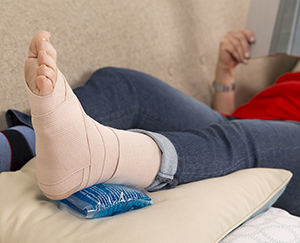RICE
RICE stands for rest, ice, compression, and elevation. Doing these things helps limit pain and swelling after an injury. RICE also helps injuries heal faster. Use RICE for sprains, strains, and severe bruises or bumps. Follow the tips on this handout and begin RICE as soon as possible after an injury.

Rest
Pain is your body’s way of telling you to rest an injured area. Whether you have hurt an elbow, hand, foot, or knee, limiting its use will prevent further injury and help you heal.
Ice
Applying ice right after an injury helps prevent swelling and reduce pain. Don’t place ice directly on your skin.
-
Use a cold pack. Or make an ice pack by putting ice cubes in a plastic bag that seals at the top. Wrap the cold pack or ice pack in a thin cloth. Place it over the injured area.
-
Ice for 10 minutes every 3 hours. Don’t ice for more than 20 minutes at a time.
Compression
Putting pressure (compression) on an injury helps prevent swelling and provides support.
-
Wrap the injured area firmly with an elastic bandage. If your hand or foot tingles, becomes discolored, or feels cold to the touch, the bandage may be too tight. Rewrap it more loosely.
-
If your bandage becomes too loose, rewrap it.
-
Don't wear an elastic bandage overnight.
Elevation
Keeping an injury elevated helps reduce swelling, pain, and throbbing. Elevation is most effective when the injury is kept elevated higher than the heart.
When to call your healthcare provider
Call your healthcare provider if you notice any of the following:
-
Fingers or toes feel numb, tingly, are cold to the touch, or change color.
-
Skin looks shiny or tight.
-
Pain, swelling, or bruising gets worse and isn't improved with elevation.
-
Signs of infection. These include warm skin, redness, fluid leaking, or bad smell coming from the injured body part.
Online Medical Reviewer:
Daphne Pierce-Smith RN MSN
Online Medical Reviewer:
Thomas N Joseph MD
Online Medical Reviewer:
Trina Bellendir PT
Date Last Reviewed:
1/1/2022
© 2000-2024 The StayWell Company, LLC. All rights reserved. This information is not intended as a substitute for professional medical care. Always follow your healthcare professional's instructions.